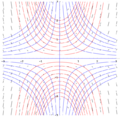- Slope field
-
In mathematics, a slope field (or direction field) is a graphical representation of the solutions of a first-order differential equation. It is achieved without solving the differential equation analytically, and thus it is useful. The representation may be used to qualitatively visualize solutions, or to numerically approximate them.
Contents
Definition
Standard case
The slope field is traditionally defined for the following type of differential equations
- y' = f(x,y).
It can be viewed as a creative way to plot a real-valued function of two real variables f(x,y) as a planar picture. Specifically, for a given pair x,y, a vector with the components [1f(x,y)] is drawn at the point x,y on the x,y-plane. Sometimes, the vector [1f(x,y)] is normalized to make the plot better looking for a human eye. A set of pairs x,y making a rectangular grid is typically used for the drawing.
An Isocline (a series of lines with the same slope) is often used to supplement the slope field. In an equation of the form y' = f(x,y), the isocline is a line in the x,y-plane plane obtained by setting f(x,y) equal to a constant.
General case of a system of differential equations
Given a system of differential equations,
the slope field is an array of slope marks in the phase space (in any number of dimensions depending on the number of relevant variables; for example, two in the case of a first-order linear ODE, as seen to the right). Each slope mark is centered at a point
 and is parallel to the vector
and is parallel to the vector .
.
The number, position, and length of the slope marks can be arbitrary. The positions are usually chosen such that the points
 make a uniform grid. The standard case, described above, represents n = 1. The general case of the slope field for systems of differential equations is not easy to visualize for n > 2.
make a uniform grid. The standard case, described above, represents n = 1. The general case of the slope field for systems of differential equations is not easy to visualize for n > 2.General application
With computers, complicated slope fields can be quickly made without tedium, and so only recently practical application is to use them merely to get the feel for what a solution should be before an explicit general solution is sought. Of course, computers can also just solve for one, if it exists.
If there is no explicit general solution, computers can use slope fields (even if they aren’t shown) to numerically find graphical solutions. Examples of such routines are Euler's method, or better, the Runge-Kutta methods.
Software for plotting slope fields
Different software packages can plot slope fields.
Example code in GNU Octave/MATLAB
Ffun = @(X,Y)X.*Y; % function f(x,y)=xy [X,Y]=meshgrid(-2:.3:2,-2:.3:2); % choose the plot sizes DY=Ffun(X,Y); DX=ones(size(DY)); % generate the plot values quiver(X,Y,DX,DY); % plot the direction field hold on; contour(X,Y,DY,[-6 -2 -1 0 1 2 6]); %add the isoclines title('Slope field and isoclines for f(x,y)=xy')
Examples
- y' = xy
See also
- Examples of differential equations
- Differential equations of mathematical physics
- Differential equations from outside physics
- Laplace transform applied to differential equations
- List of dynamical systems and differential equations topics
References
- Blanchard, Paul; Devaney, Robert L.; and Hall, Glen R. (2002). Differential Equations (2nd ed.). Brooks/Cole: Thompson Learning. ISBN 0-534-38514-1
External links
Categories:- Calculus
- Differential equations
Wikimedia Foundation. 2010.








